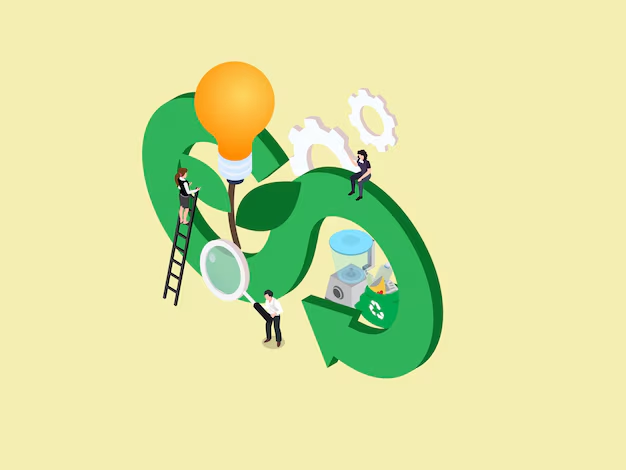In today’s world, e – commerce is booming, and the concept of the circular economy is gaining traction. When these two forces come together, there is a great potential to reduce waste and increase value in the business ecosystem. Let’s explore how e – commerce can contribute to the circular economy and what benefits it brings.

I. Understanding the Circular Economy and E – Commerce
A. What is the Circular Economy?
- Principles of Circular Economy
The circular economy is based on three main principles: reduce, reuse, and recycle. It aims to keep resources in use for as long as possible, extract the maximum value from them, and then recover and regenerate products and materials at the end of their life cycle. For example, instead of throwing away old furniture, it can be repaired, refurbished, and resold. - Benefits for the Environment and Economy
This approach has significant benefits for both the environment and the economy. It reduces the demand for raw materials, decreases waste sent to landfills, and can create new business opportunities. For instance, recycling materials can save energy and reduce pollution associated with extracting and processing new resources.
B. The Role of E – Commerce in the Circular Economy
- Expanding the Reach of Circular Practices
E – commerce platforms have a wide reach, which can help promote circular economy practices. They can connect sellers of second – hand or refurbished products with a large number of potential buyers. For example, an online marketplace can offer a platform for people to sell their used clothes, extending the life of these items. - Data – Driven Insights for Sustainability
E – commerce generates a vast amount of data. This data can be used to understand consumer behavior and preferences related to sustainable products. For example, by analyzing data, e – commerce companies can identify which types of recycled or upcycled products are more popular and adjust their offerings accordingly.
II. How E – Commerce Can Reduce Waste
A. Encouraging Second – Hand Sales
- Online Marketplaces for Used Goods
There are many online marketplaces dedicated to second – hand goods. Platforms like eBay and Depop allow individuals to sell their pre – owned items. This reduces the need for new products to be manufactured, thus conserving resources. For example, a person can sell their old smartphone on these platforms, and someone else can buy it at a lower price, extending the phone’s useful life. - Reducing Fast Fashion Waste
In the fashion industry, e – commerce has enabled the growth of second – hand fashion platforms. This helps combat the problem of fast fashion waste. Instead of clothes being discarded after a few wears, they can be resold. For instance, ThredUp is an online thrift store that makes it easy for people to buy and sell used clothing.
B. Optimizing Packaging
- Using Sustainable Packaging Materials
E – commerce companies are increasingly turning to sustainable packaging materials. This includes using recycled cardboard, biodegradable plastics, and paper – based packaging. For example, some companies are replacing single – use plastic bags with compostable mailers for shipping products. - Reducing Excessive Packaging
By analyzing shipping data, e – commerce companies can also reduce excessive packaging. They can find the right size of packaging for each product, minimizing the use of unnecessary materials. For instance, instead of using a large box for a small item, they can use a more appropriately sized package.

III. How E – Commerce Can Increase Value
A. Promoting Upcycling and Repurposing
- Showcasing Upcycled Products
E – commerce platforms can promote upcycled products. Upcycling is the process of transforming waste materials or unwanted products into new items of higher value. For example, an online store can feature products made from recycled materials, such as bags made from old tires or furniture made from reclaimed wood. - Educating Consumers about Upcycling
These platforms can also educate consumers about the benefits of upcycling. By providing information about the products’ origin and the environmental impact of upcycling, they can increase consumers’ appreciation for these items. For example, a product description can explain how a particular item was created from waste materials and why it is a more sustainable choice.
B. Extending Product Lifetimes through Maintenance and Repair Services
- Offering Product Maintenance Guides
E – commerce companies can offer product maintenance guides on their platforms. This helps consumers take better care of their purchases, extending the products’ lifetimes. For example, a camera retailer can provide online guides on how to clean and maintain cameras. - Connecting Consumers with Repair Services
They can also connect consumers with repair services. Instead of replacing a broken product, consumers can have it repaired. For instance, an electronics e – commerce site can list local repair shops or offer its own repair services for the products it sells.
IV. Challenges and Solutions in Combining E – Commerce and the Circular Economy
A. Challenges
- Consumer Perception and Education
Some consumers may still have a preference for new products and may not fully understand the benefits of the circular economy. There is a need to educate consumers about the environmental and economic advantages of buying second – hand or upcycled products. - Logistics and Supply Chain Complexity
Implementing circular economy practices in e – commerce can be complex, especially in terms of logistics and supply chain management. For example, collecting and transporting used products for recycling or refurbishing can be challenging.
B. Solutions
- Marketing and Awareness Campaigns
E – commerce companies can run marketing and awareness campaigns to change consumer perception. They can highlight the benefits of the circular economy and promote sustainable products. For example, they can use social media to showcase success stories of circular economy practices. - Collaboration in the Supply Chain
To address logistics and supply chain issues, e – commerce companies can collaborate with other stakeholders. This includes working with recycling companies, repair shops, and logistics providers. For example, an e – commerce company can partner with a local recycling center to ensure the proper disposal and recycling of returned products.

In conclusion, the combination of e – commerce and the circular economy has great potential to reduce waste and increase value. By implementing the strategies mentioned above and overcoming the challenges, e – commerce can play a significant role in creating a more sustainable and economically viable future. As technology and consumer awareness continue to grow, we can expect even more innovation in this area.



